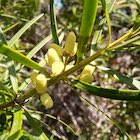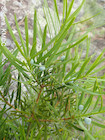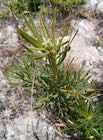Podocarpus capuronii
de Laub. 1971
Common names
No designated common names. The name would transliterate as Capuron's yellowwood.
Taxonomic notes
Type: Madagascar, Fianarantsoa Province, Itremo Massif, Mt. Ambatomenaloha. R. Capuron 11566 (holotype P). Farjon (2010) notes that the type specimens of P. capuronii and P. woltzii were collected by R. Capuron on the same day, albeit on different mountains. Synonyms: Podocarpus woltzii Gaussen 1974, P. capuronii de Laub. var. woltzii (Gaussen) Silba 2000. Stockey et al. (1998), performing a detailed review of leaf anatomy, conclude that "while these two species [P. capuronii and P. woltzii] show many similarities in micromorphology, they can still be distinguished by a number of features, indicating that they may indeed be separate taxa." However, this review considered only a single specimen from each taxon, and thus cannot estimate the variance in these traits. There have been few herbarium collections of either taxon (a 2023 review found 48 specimens labeled P. capuronii and 28 labeled P. woltzii) and any possible other differences are not well known.
This species joins the other Madagascar Podocarpus in subgenus Podocarpus, section Scytopodium, in the classification of de Laubenfels (1985). Systematics in Podocarpus tend to be closely correlated with geography. The molecular analysis by Knopf et al. (2012), which addressed 57 species within Podocarpus, considered two Madagascar species, P. capuronii and P. madagascariensis, placing both in a clade of African Podocarpus species.
Description
Shrubs, or trees to 20 m tall. Bark breaking in small irregular flakes, brown. Twigs round, finely grooved, with terminal buds bearing elongate, incurved scales. Leaves crowded near ends of twigs, mostly spreading forward at 35-45°, dark green above but first flushing a bright glaucous blue, coriaceous, linear, 25-50 × 2-5 mm, straight or slightly falcate, gradually narrowing to a sessile or short-petiolate base, margins slightly revolute, apex obtuse or minutely acuminate; midrib slender, raised but fading toward apex on upper side, continuous and conspicuous on lower side. Stomata small, in intermittent lines on either side of midrib. Pollen cones axillary in groups of 1-3 on 4-8 mm peduncles, elongating to 1-2 cm, 3-4 mm wide when fertile. Seed cones axillary, solitary, short-peduncled, with a receptacle formed of 2 unequal bracts that swells only slightly. Seeds within epimatium 15-18 × 10-12 mm, oblique-ovoid with a distal crest, brown to bluish or whitish pruinose (Farjon 2010).
This species is distinguished from other Madagascar Podocarpus by the elongate foliage buds and the leaves 2-5 mm wide and up to 75 mm long (foliage from mature trees, not saplings) (Farjon 2010).
Distribution and Ecology
Madagascar: Farjon (1998, 2013) asserts that the species is currently restricted to the Itremo Massif, including Mt. Ambatomenaloha and Mt. Tsaratanana, where it occurs at elevations of 1320-2000(-2800) m on shallow sandy soil over quartzite or gneiss, along streams in ravines and on rocky slopes and ridges. This region corresponds to all extant iNaturalist observations, as well. However, the map shown below identifies additional occurrences in northern Madagascar, some located within forest reserves, some verified by credible sources (e.g. de Laubenfels).
Distribution data for all species native to Madagascar, based on identified specimens listed by GBIF (2023). Each point includes a link to more data and, in most cases, an image. Podocarpus capuronii shown in green.
The IUCN classifies this species as "Endangered" due to a very limited range (probably restricted to the Itremo Massif), at a total are of four or five locations. Its range was formerly more extensive, but habitat loss is very high in the whole of central Madagascar due to deforestation, cutting for firewood, fires, and grazing. Within the species' remaining range, habitat loss due to fires and overgrazing are the main, ongoing threats. Some subpopulations are in a designated protected area (Farjon 2013).
Remarkable Specimens
No data as of 2023.02.05.
Ethnobotany
No use has been recorded, but it was likely used as firewood when still abundant, and perhaps locally for construction and carpentry (Farjon 2013).
Observations
See the map above, and the collection records on iNaturalist.
Remarks
The epithet honors botanist R. Capuron, who collected the type specimen.
Citations
Farjon, Aljos. 2013. Podocarpus brasiliensis. The IUCN Red List of Threatened Species 2013: e.T34160A2848779. https://dx.doi.org/10.2305/IUCN.UK.2013-1.RLTS.T34160A2848779.en, accessed 2023.01.06.
Gaussen. 1974. Un Nouveau Podocarpus de Madagascar. Bull. Soc. Hist. Nat. Toulouse 110:122. Available: Gallica, accessed 2023.01.04.
Laubenfels, D. J. de. 1971. Deux nouveaux Podocarpus endemiques de Madagascar. Adansonia ser. 2, 11(4):713-714. Available: Biodiversity Heritage Library, accessed 2022.12.23.
Stockey, Ruth A., Brenda J. Frevel, and Philippe Woltz. 1998. Cuticle micromorphology of Podocarpus, subgenus Podocarpus, section Scytopodium (Podocarpaceae) of Madagascar and South Africa. International Journal of Plant Sciences 159(6):923-940.
See also
The species account at Threatened Conifers of the World.




